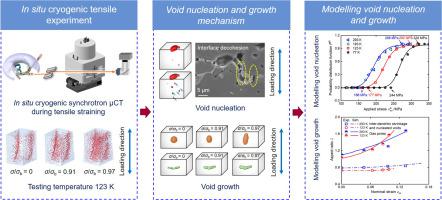当前位置:
X-MOL 学术
›
Int. J. Mech. Sci.
›
论文详情
Our official English website, www.x-mol.net, welcomes your feedback! (Note: you will need to create a separate account there.)
Void nucleation and growth behavior of TIG welded AA2219 deformed at cryogenic temperatures
International Journal of Mechanical Sciences ( IF 7.3 ) Pub Date : 2024-03-29 , DOI: 10.1016/j.ijmecsci.2024.109221 Yanan Hu , Shengchuan Wu , Ziyi Wang , Fandong Meng , Yanling Xue , Yanan Fu , Guozheng Kang , Philip J. Withers
International Journal of Mechanical Sciences ( IF 7.3 ) Pub Date : 2024-03-29 , DOI: 10.1016/j.ijmecsci.2024.109221 Yanan Hu , Shengchuan Wu , Ziyi Wang , Fandong Meng , Yanling Xue , Yanan Fu , Guozheng Kang , Philip J. Withers

|
This work investigates the failure behaviour of tungsten inert gas (TIG) welded 2219 aluminum alloy butt welds deformed over a range of cryogenic temperatures relevant to liquid hydrogen/oxygen propellent storage tanks. A novel tensile testing machine, able to deform samples at temperatures down to 83 K, was designed to be accommodated on synchrotron computed tomography beamlines. In this way we were able to observe the accumulation of damage from void nucleation through growth to coalescence and ultimate failure by time-lapse X-ray microtomography during tensile straining at 293 K and 123 K. The results reveal that micro-void nucleation is triggered by θ (AlCu) precipitates and α-Al + θ (AlCu) eutectics in the form of particle fracture and interface decohesion. After nucleation, these freshly nucleated voids, along with pre-existing welding defects, extend with straining along the loading direction. This leads to void linkage, a very short void coalescence stage and subsequent catastrophic failure. The probability distribution function that describes the rate at which voids nucleate by interface decohesion considering the particle orientation was determined through the Eshelby inclusion theory. The evolution of void aspect ratio and void growth were modelled using the Gurson-Tvergaard-Needleman model and Le Roy model, respectively. This suggests that pre-existing defects grow faster, but that the numerous closely spaced nucleated voids play a significant role in failure.
中文翻译:

TIG 焊接 AA2219 在低温下变形的空洞形核和生长行为
这项工作研究了钨惰性气体 (TIG) 焊接 2219 铝合金对接焊缝在与液氢/氧推进剂储罐相关的一系列低温下变形的失效行为。一种新型拉伸试验机能够在低至 83 K 的温度下使样品变形,设计用于安装在同步加速器计算机断层扫描光束线上。通过这种方式,我们能够通过延时 X 射线显微断层扫描在 293 K 和 123 K 拉伸应变期间观察到从空洞成核到生长到聚结和最终失效的损伤累积。结果表明微空洞成核被触发由θ(AlCu)析出物和α-Al+θ(AlCu)共晶以颗粒破裂和界面脱聚的形式产生。成核后,这些新成核的空隙以及预先存在的焊接缺陷随着应变沿加载方向延伸。这会导致空洞连接、非常短的空洞合并阶段以及随后的灾难性故障。通过埃谢尔比夹杂理论确定了描述考虑颗粒方向的界面脱聚导致空隙成核的速率的概率分布函数。分别使用 Gurson-Tvergaard-Needleman 模型和 Le Roy 模型对孔隙纵横比的演变和孔隙生长进行建模。这表明预先存在的缺陷增长得更快,但大量紧密排列的成核空洞在失效中起着重要作用。
更新日期:2024-03-29
中文翻译:

TIG 焊接 AA2219 在低温下变形的空洞形核和生长行为
这项工作研究了钨惰性气体 (TIG) 焊接 2219 铝合金对接焊缝在与液氢/氧推进剂储罐相关的一系列低温下变形的失效行为。一种新型拉伸试验机能够在低至 83 K 的温度下使样品变形,设计用于安装在同步加速器计算机断层扫描光束线上。通过这种方式,我们能够通过延时 X 射线显微断层扫描在 293 K 和 123 K 拉伸应变期间观察到从空洞成核到生长到聚结和最终失效的损伤累积。结果表明微空洞成核被触发由θ(AlCu)析出物和α-Al+θ(AlCu)共晶以颗粒破裂和界面脱聚的形式产生。成核后,这些新成核的空隙以及预先存在的焊接缺陷随着应变沿加载方向延伸。这会导致空洞连接、非常短的空洞合并阶段以及随后的灾难性故障。通过埃谢尔比夹杂理论确定了描述考虑颗粒方向的界面脱聚导致空隙成核的速率的概率分布函数。分别使用 Gurson-Tvergaard-Needleman 模型和 Le Roy 模型对孔隙纵横比的演变和孔隙生长进行建模。这表明预先存在的缺陷增长得更快,但大量紧密排列的成核空洞在失效中起着重要作用。



























 京公网安备 11010802027423号
京公网安备 11010802027423号